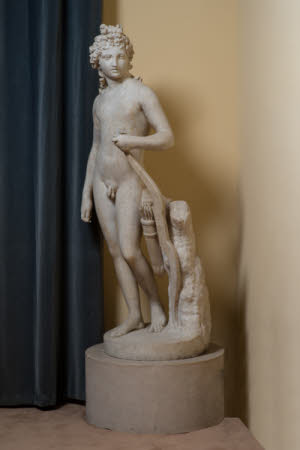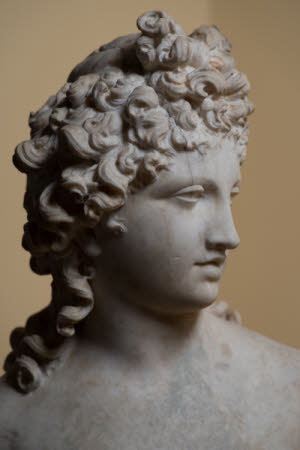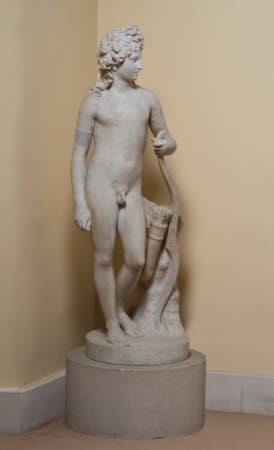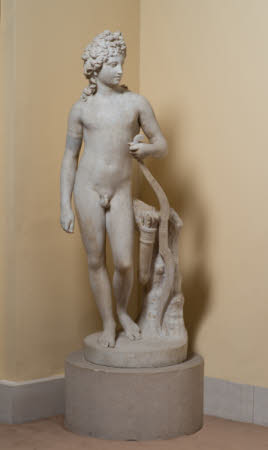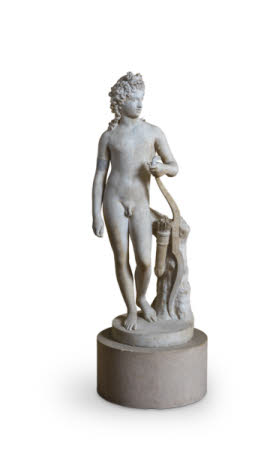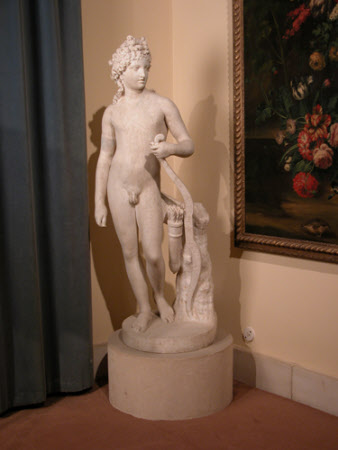Amorino
Antonio Canova (Possagno 1757 - Venice 1822)
Category
Art / Sculpture
Date
1788 - 1789
Materials
Marble
Measurements
1416 x 520 x 500 mm
Place of origin
Rome
Order this imageCollection
Anglesey Abbey, Cambridgeshire
NT 516599
Caption
This marble figure of a young naked boy posing with his bow and arrow was carved by one of the most celebrated Italian sculptors of his age, Antonio Canova (1757–1822). The son of a stone mason, Canova was an outstandingly talented sculptor who worked principally in marble and won commissions from collectors across Europe, including the Emperor Napoleon (1769–1821). This figure was commissioned directly from the artist by Colonel John Campbell, later Baron Cawdor (1755–1821), when he was travelling in Italy in 1786. The artist and the patron became good friends, and when the sculpture was completed in 1789, Campbell was so delighted with it that he paid more than Canova had originally asked. It was installed in his house in London on a revolving platform so that the skill of the artist could be admired from all angles. By the 20th century this statue had somehow lost its identity and its attribution to the famous artist. It was sold in 1965 as a French ‘marble figure of Apollo’ and put on display at Anglesey Abbey as a garden ornament, later reidentified as a famous work by Canova.
Summary
Marble, Amorino, by Antonio Canova (Possagno 1757 - Venice 1822), 1788-89. A marble sculpture by Antonio Canova (Possagno 1757 - Venice 1822) entitled Amorino, depicting Cupid, the god of love, standing with his bow next to a small tree trunk, from which hangs his quiver. The statue, one of five versions of this model to have been made by Canova, was commissioned in 1787 by Colonel John Campbell, later first Baron Cawdor of Castlemartin (1755–1821), and arrived in London in 1790. When acquired by Lord Fairhaven in 1964, it was serving as a garden sculpture, and was first displayed at Anglesey Abbey in the gardens. It has as a result suffered significant wear to the surfaces, and a number of losses.
Full description
A marble sculpture by Antonio Canova (Possagno 1757 - Venice 1822) entitled Amorino, depicting Cupid, the god of love. A nude adolescent boy, standing with right foot slightly forward, head turned to the left, holding the end of his bow. Stands next to small tree trunk, from which hangs his quiver; bow and quiver both decorated with scrolling foliage. On an integral plain circular marble plinth, placed on a modern circular base. The leading Neo-classical sculptor in the decades around 1800, Antonio Canova (1757-1822) was one of the most famous artists of his day. Neo-classicism became highly fashionable from the 1750s onwards, partly as a reaction against the exuberance of the rococo style but, more importantly, as a response to the extraordinary archaeological discoveries being made around this time, especially at Pompeii and Herculaneum. Neo-classical painters and sculptors sought to recapture, within a modern idiom, not only the aesthetic beauty of ancient Classical art, but also what was then regarded as its moral purity, so that viewers would be both delighted and elevated. The art historian Johann Joachim Winckelmann wrote of how, when looking at a sculptural masterpiece, ‘I myself adopt an elevated stance, in order to be worthy of gazing on it.’ The subject matter of Neo-classical sculptures is therefore generally elevated and is very often taken from ancient Greek and Roman history and mythology. Canova was born in Possagno, in the Veneto. He began his career in Venice, but moved as a young man to Rome, where he spent the remainder of his career. Few artists before or since have been so widely admired in their own lifetimes, with emperors, princes and other wealthy patrons vying to obtain his work for their collections. The most important collectors of his sculptures in Britain were the Prince Regent, later King George IV, and the Sixth Duke of Devonshire. There are still today significant groups of Canova’s works in the Royal Collection and at Chatsworth. However, Canova’s most important early British patron was John Pryse Campbell, first Baron Cawdor of Castlemartin (1755–1821), who commissioned the version of the Amorino now at Anglesey Abbey. The figure of the young Cupid, or Amorino, was one of the first of the idealising purely neo-classical standing figures which would come to be regarded as among Canova’s finest and most characteristic works. It was nevertheless a model with which the artist struggled to find a solution that entirely satisfied him, hence the variations within the five successive versions. The first reference to a large statue of an ‘amorino’ comes in an entry dated 5 June 1786 in one of Canova’s notebooks, when he wrote that he was working on ‘the large model of an Amorino’ (‘il modello grande dell’amorino’). On 2 July Canova recorded that he had passed the clay model to the workman to make a plaster cast from it, and then on 4 August wrote that he had bought from the restorer Carlo Albacini ‘am antique statue with which to make the Amorino’ (‘una statua antica per fare il sud.to Amorino’). This was a very low sum for an antiquity and it seems that Canova bought what was presumably a ruined work, from which to make his new marble statue. There is no mention in 1786 of whether Canova had actually as yet received a commission for an Amorino. However, two years later, in 1788, the sculptor noted that he was working on two statues of the subject, conceived in the guise of a ten-year old boy, one for Princess Elzbieta Lubomirska and the other for ‘il Colonello Campbell, Cav[alie]re Inglese’. The second of these sculptures, for Colonel Campbell, is the version now at Anglesey Abbey. The first version was commissioned by Princess Lubomirska as a portrait of her nephew Prince Henryk Lubomirski (1777-1850), whose education she was supervising and with whom she was travelling through Europe, on a journey which included the obligatory stay in Rome. The statue, with its idealised portrait of the young prince, was completed by October 1788 and was sent, after payment, to the family castle in Lańcut, where it has remained to this day (for this statue, see Canova e la Venere Vincitrice, pp. 170-71, but especially the exhibition catalogue Antonio Canova: Il principe Henryk Lubomirski come Amore). Whereas Canova by all accounts disliked the notion of having to include a portrait in the version commissioned from him by the importunate princess, he would have been much more enthusiastic about the second version, ordered in 1787 by the British collector Colonel John Campbell, later first Baron Cawdor of Castlemartin (1755–1821), with whom the sculptor developed a deep bond of friendship and who would in fact become the sculptor’s most important British patron. Towards the end of the 17th century, the ancient Scottish Cawdor family began to seek advancement in England and in Wales, where it acquired the extensive Stackpole estate in Pembrokeshire (John E. Davies, The Changing Fortunes of a British Aristocratic Family 1689-1976. The Campbells of Cawdor and their Welsh Estates, Woodbridge 2019). When elevated to the peerage in 1796, John Campbell chose for his territorial designation the local village of Castlemartin in Pembrokeshire. An army officer and politician, Campbell became a major collector, establishing a small museum in his house on Oxford Street, London, which financial pressures forced him to sell in 1800 (Davies, The Changing Fortunes of a British Aristocratic Family, p. 278). Campbell travelled extensively in Italy, visiting the country on a number of occasions from 1777 and into the 1780s. As well as the Amorino, Campbell also commissioned from Canova the first version of his celebrated Cupid and Pysche group, which was only completed in 1793, but could not be transported to Britain because of the European wars. In 1798 it was bought by Napoleon’s brother-in-law Joachim Murat and is today one of the most famous and popular works in the Musée du Louvre, Paris. Campbell commissioned a painting referring to this commission, a pastel portrait by Hugh Douglas Hamilton depicting Antonio Canova in his studio with Henry Tresham and a plaster model for Cupid and Psyche (version in Victoria & Albert Museum, London, Inv. E.406-1998). In 1814, Campbell made another visit to Rome, where he would play some part in the repatriation from Paris of works of art to the Vatican, in gratitude for which Canova presented him with a marble bust of Peace. This sculpture was recently rediscovered, sold at auction (‘Canova, Bust of Peace’, Sotheby’s London, 4 July 2018) and subsequently exported from the UK. Finally, when he was again in Rome in 1815, Campbell commissioned yet another work from Canova, a version of the statue of Hebe, acquired after his death by the Dukes of Devonshire and today at Chatsworth. Campbell’s Amorino differs from the Lubomirski version essentially in the substitution of the portrait head of the young prince by a more idealised image of a boy. The plaster model at Possagno, partly destroyed during the First World War, seems to have been much closer to Campbell’s Amorino than to that made for Princess Lubomirska, which makes it likely that it was intended for the version now at Anglesey Abbey (Honour, ‘Gli Amorini di Canova’, figs. 6-7). Work on blocking out the sculpture was begun by one of Canova’s assistants Gaetano Ceroti, but the major part was undertaken by Canova himself. In a short manuscript from 1787 listing the sculptures he had made, the sculptor recorded that ‘I am now working, or more accurately completing, two Amorini of around the size of a ten-year old boy, the one with the portrait of a young lord, nephew of the Princess Lubomirski of Warsaw, and the other with an idealised head for Colonel Campbell, an English [sic] gentleman…’ (‘Note di Antonio Canova sulle proprie opera [1787’ in Antonio Canova. Scritti, p. 161). Canova again recorded the Campbell Amorino in another autograph note, listing the works he had made whilst in Rome, by date: ‘4 – the year 1787. A statue of Amorino …, the figure alone three feet ten inches high, commissioned by Colonel Campbell from England, for the price of five hundred zecchini, to which he added a further one hundred as a gift’ (‘Nota di lavori di Antonio Canova per ordine de’tempi nella sua dimora in Roma (1795)’, in Antonio Canova. Scritti, pp. 288-89). A contemporary list of the sculptor’s works published in 1817 recorded the date of the Campbell Amorino as 1789, presumably the year of its completion (Antonio Canova. Scritti, p. 465). A travelling companion of John David La Touche, who would commission a further version of the model, visited Canova’s studio in Rome on 27 April 1789, and recorded seeing there the Lubomirski Amorino and also ‘another Cupid of fancy’, which was presumably Campbell’s version (Benedetti, The La Touche Amorino, p. 25, note 2). The statue was sent in 1790 to London, together with a platform on which the figure could be rotated. As Canova himself noted, he asked 500 zecchini for the sculpture but Cawdor, regarding this as too modest a price, added a further 100 zecchini. Despite clearly having taken much trouble over this commission for his friend, Canova seems not to have been entirely satisfied with the outcome. In the summer of 1789, a third version was ordered, for the Irish banker John David La Touche, who was in Rome from May to July of that year. It was completed in 1791 and had arrived in Dublin by August 1792 Discovered a few years ago in a West Country garden, it was restored and is now in the National Gallery of Ireland, Dublin, (Benedetti, The La Touche Amorino; Canova e la Venere Vincitrice, pp. 174-75). The fourth version of the model was commissioned from the Russian prince Yusopov, probably in 1792 or 1793 and seems to have been completed in the early months of 1795. Now in the State Hermitage Museum, St. Petersburg, it differs from the other versions principally in that Cupid is here equipped with a pair of large wings (Canova e la Venere Vincitrice, pp. 176-77). A sculpture in the civic museums in Bologna, long regarded as a later copy, has been recently identified as Canova’s fifth version of the theme, made around 1797 and once in the Parisian collection of Giovanni Battista Sommariva (Canova, Thorwaldsen, pp. 239, 367-68, no. XI.1). This version includes a serpent wound around the tree trunk, alluding to the classical story of Apollo’s slaying of the serpent Python, recounted by the Roman poet Ovid in his Metamorphoses (I, 439-49). During his lifetime Antonio Canova periodically made plaster casts of his principal works that he would give to friends and patrons. There is a plaster version of the Amorino in the Museo Correr, Venice, whilst another contemporary plaster cast of the Campbell Amorino is in a private collection in Rome (Canova. Eterna Bellezza, pp. 303-04, no. 61). A portrait of the sculptor, by Domenico Conti Bazzani, depicts Canova in his studio working on this very sculpture and shows that he originally held a complete arrow in his right hand (Canova. Eterna Bellezza, pp. 35-36, fig. 15). Colonel Campbell’s Amorino was the first work by Canova to reach Britain and quickly became one of the most admired modern works of sculpture in a British collection. Campbell himself wrote to Canova in a letter from late 1790 or early 1791 to tell him that the sculpture had safely arrived and had been much admired by the collector Charles Townley, whose fabulous collection of Roman sculptures is now in the British Museum. According to Campbell, Townley had described the Amorino as ‘the most beautiful work in the most pure taste that exists from the great age of the Greeks. Everyone else says the same. Tresham [Henry Tresham (c. 1751-1814, an historical painter who lived in Rome for a number of years, and acted as an intermediary between Canova and Colonel Campbell] says that if it belonged to him, he would be unable to sleep if he could not be sure it were safely under lock and key’ (‘l’opera la più bella e nel gusto il più puro che esiste dal buon tempo de’ Greci. Tutti gli altri sono dell’istesso sentimento. Tresham dice, se fosse suo, non dormirebbe mai se non fosse sotto chiave.’ Il carteggio Canova-Quatremère de Quincy, p. 9). A few years later in 1800, James Dallaway commented that ‘Lord Cawdor is possessed of an exquisite statue of Cupid, which amply entitles this singular artist to the highest commendation.’ However, not every contemporary observer was as effusive in admiration of the composition of the Amorino. In 1806, The Swiss art historian Karl Ludwig Fernow, who criticised a number of Canova’s works in his survey, wrote (not unperceptively) in the context of the Lubomirski version of the Amorino, that ‘The sculptor succeeded in this sculpture in capturing well the tenderness of boyhood adolescence, but the pose is a little too upright and stiff, lacking that pleasing notion of deliberate opposition which the ancients were accustomed to give their stationary figures and through which they knew how to bring out, even in their resting figures, a sense of movement.’ (‘Das Zarte des Knabenalters war in dieser Statue wohl gelungen, aber die Stellung war etwas gerade und steif, ohne jene gefällige Entgegensetzung, welche die Alten ihren ruhenden Gestalten zu geben, und dadurch auch in der Ruhe Bewegung auszudrücken wussten.‘ Fernow 1806, p. 93). Perhaps Fernow here grasped one of the reasons why Canova seems to have remained always a little unsatisfied with his successive versions of the Amorino, with the exception perhaps of the one he made for Prince Yusopov. It is not known precisely when the Amorino left the collections of Lord Cawdor, but the family sold works of art periodically throughout the nineteenth and twentieth centuries (Davies, The Changing Fortunes of a British Aristocratic Family, p. 280). It was by the 1930s in the Leigh-Pemberton collection at Torry Hill in Kent, before being sold at Christie’s in 1937, where it was bought by Basil Ionides and his wife Nellie, for their country home at Buxted Park in Sussex. When it was at Torry Hill, the sculpture was apparently displayed indoors in the Hall. At the time of its sale in 1937, it still retained its revolving circular pedestal, described in the catalogue as 33 inches (84 cms.) high and as ‘sculptured in relief with eagles suspending festoons of flowers within foliage borders.’ It is not known where the sculpture was first displayed at Buxted Park, which suffered a serious fire on the night of February 2-3 1940, in which much of the contents of the house were destroyed. Conceivably the sculpture was indoors, the pedestal was destroyed in the fire and the statue damaged at that time. It was however certainly displayed in the gardens at Buxted following the fire, and it was during this period that its identity as a work by Canova was lost. After Mrs Ionides’ death in 1962, her wide-ranging collections were dispersed in a long series of sales at Sotheby’s that went on into 1964. A number of sculptures from her collection, ivories, marbles, bronzes and terracottas, were among the last items from her estate to be sold, at Sotheby’s on 24 July 1964, however, these were all smaller sculptures from inside the house and the Amorino as a garden sculpture was not in the sale. It may well be that Bert Crowther bought the sculpture privately from the Ionides estate. He advertised it, looking very dirty from its long exposure to the elements, in a Supplement to Country Life, 3 December 1964 (p. 46), as a French mid-eighteenth century work. Lord Fairhaven immediately expressed interest in the figure. A reply from Messrs. Crowther, dated 15 December 1964, explained that ‘the sculpture has been out in the open for some considerable time and is beautifully weathered.’ The photograph of the Amorino used in the Country Life advertisement, a copy of which was sent to Lord Fairhaven with the letter, showed that the sculpture was in 1964 much as it is today. This indicates that the restorations it has undergone are likely to have been mainly undertaken whilst it was in the possession of Mr and Mrs Ionides. Jeremy Warren March 2022
Provenance
Purchased in 1789 by John Campbell, 1st Baron Cawdor, from Antonio Canova; acquired by Thomas Pemberton, 1st Baron Kingsdown (1793-1867) of Torry Hill, Kent; sold by D. Leigh Pemberton, Christie’s, 22 July 1937 (lot 20); purchased by Frank Partridge; purchased by Mr and the Hon. Mrs Basil Ionides of Buxted Place, Sussex; purchased by Thomas Crowther & Son, 1964; purchased by Urban Huttleston Rogers Broughton, 1st Lord Fairhaven (1896-1966), 1965; bequeathed to the National Trust with the house and the rest of the contents in 1966.
Makers and roles
Antonio Canova (Possagno 1757 - Venice 1822), sculptor
References
Tadini 1796: Fausto Tadini, Le Sculture e le Pitture di Antonio Canova pubblicate fino a quest’anno 1795, Venice 1796 (new edition, ed, Gianni Venturi, Bassano del Grappa 1998), pp. 43-44. Dallaway, James,. Anecdotes of the arts in England; [1800]., pp. 394-95. Federici 1803: Domenico Maria Federici, Le Memorie trevigiane sulle opere di disegno, Venice 1803, II, p. 195. Fernow 1806: Karl Ludwig Fernow, Über den Bildhauer Canova und dessen Werke, Zurich 1806, p. 93. Canova 1817: Antonio Canova, Catalogo cronologico delle sculture di Antonio Canova, Rome 1817 Paravia 1822: Pier Alessandro Paravia, Notizie intorno alla vita di Antonio Canova, Venice 1822, Appendix, unpaginated. Albrizzi 1822-24: Isabella Albrizzi, Opere di Scultura e di Plastica di Antonio Canova, 4 vols., Pisa 1821-24, III, pp. 51-53, no. XCII; IV, p. 118. Cicognara 1823: Leopoldo Cicognara, Biografia di Antonio Canova, Venice 1823, pp. 58, 85. Missirini 1824-25: Melchior Missirini, Della vita di Antonio Canova : libri quattro, 2 vols., Milan 1824-25, I, p. 74. Memes, J. S. (John Smythe) Memoirs of Antonio Canova, 1825., pp. 330, 572. d'Este 1864: Antonio d’Este, Memorie di Antonio Canova, Florence 1864 (new edition, ed. Paolo Mariuz, Bassano del Grappa 1999), pp. 305, 371. Age of Neo-Classicism, Royal Academy (Council of Europe), London, 1972, pp. 201-02, no. 309. Honour 1972: Hugh Honour, ‘Canova's Studio Practice-I: The Early Years’, The Burlington Magazine, Vol. 114, No. 828 (March 1972), pp. 146-156 & 159., p. 155. Honour 1973: Hugh Honour, ‘Gli Amorini di Canova’, Arte Illustrata, VI (1973), pp. 312-20., pp. 315-17, fig.8. Pavanello 1976: Giuseppe Pavanello, L’opera completa del Canova, Milan 1976, p. 93, no. 33. Honour 1994: Hugh Honour, ‘Canova’s Amorini for John Campbell and John David La Touche’, Antologia di Belle Arti, no 48-51 (1994), pp. 129-40. Benedetti 1998: Sergio Benedetti, The La Touche Amorino: Canova and His Fashionable Irish Patrons, National Gallery of Ireland, 1998, pp. 24-25, figs. 13-14. Pavanello 2005: Giuseppe Pavanello, ed. Il carteggio Canova-Quatremère de Quincy 1785-1822. Nell’edizione di Francesco Paolo Luiso, Treviso 2005, p. 9, notes 3-4. Honour and Mariuz 2007: Hugh Honour and Paolo Mariuz (eds.), Antonio Canova. Scritti, Rome 2007, pp. 203, 225 (note 17), 257, 258, 261, 287, 289, 321, 326, 347, 465-66. Coliva and Mazzocca 2007: Anna Coliva and Fernando Mazzocca, eds., Canova e la Venere Vincitrice, exh. cat., Galleria Borghese, Rome 2007., pp. 172-73. Honour 2007: Hugh Honour, ‘Amorini del Canova’ in ed. Mario Guderzo, Antonio Canova. Il principe Henryk Lubomirski come Amore, exh. cat., Possagno, Museo Gipsoteca Canoviana, Milan 2007, pp. 28-41., esp. pp. 32-35 Sotheby's 2018: Canova Bust of Peace, Sotheby’s London 2018, p. 10. Campanelli 2008: Alessandro Pergoli Campanelli, ‘I quattro “amorini” di Antonio Canova e il tema del restauro delle superfici’, L’Architetto Italiano, V, nos. 26-27 (June-September 2008), pp. 96-98. Leone 2013: Francesco Leone, ‘John Campbell commitente di Canova’, Studi Neoclassici, 1 (2013), pp. 127-46, pp. 132-34, fig. 3. Androsov, Bertelli, Spalletti 2017: Sergei Androsov, Massimo Bertozzi and Ettore Spelletti, Dopo Canova. Percorsi della scultura a Firenze e Roma, exh. cat., Palazzo Cucchiari, Carrara 2017, p. 130. Pavanello 2019: Giuseppe Pavanello, ed., Canova. Eterna Bellezza, exh. cat., Museo di Roma, Milan 2019, pp. 35-36; pp. 303-04. Grandesso and Mazzocca 2019: Stefano Grandesso and Fernando Mazzocca, eds., Canova, Thorwaldsen. La nascita della scultura moderna, exh. cat., Gallerie d’Italia, Milan 2019, pp. 63-64, 367. Christie, Manson & Woods 1971: The National Trust, Anglesey Abbey, Cambridge. Inventory: Furniture, Textiles, Porcelain, Bronzes, Sculpture and Garden Ornaments’, 1971, p. 159. Leone 2022: Francesco Leone,'Antonio Canova. La vita e l'opera', Rome 2022, pp. 101, 105, 109-112, 115
